 Commonwealth of Australia (1942-1943)
Commonwealth of Australia (1942-1943)
Cruiser Tank – 1 Prototype Built
The one with the big gun
Another offspring of the AC I Sentinel was the AC IV, which was to be equipped with the new British Ordnance QF 17-pounder anti-tank gun. After the July 1942 decision to proceed with increased armament for the Australian Cruisers, a plan for expedited local production of 17 pounders was initiated to replace the previously planned 6 pounder production.
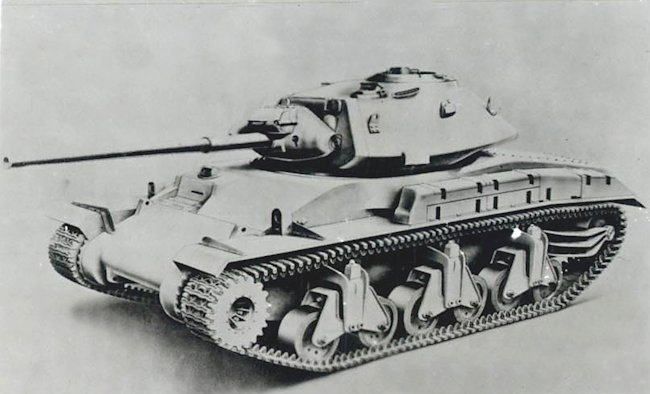
Artists rendition of the AC IV. Source: National Australian Archives MP730 10
A new prototype turret was fabricated to facilitate mounting the 17 pounder gun, and fitted to the E1 prototype hull. The new turret had increased dimensions over the previous AC I and AC III turrets, notably featuring a slightly taller roof and an extended rear bustle with an angled rear facing as opposed to the vertical rear face of the previous types. The turret ring diameter was also increased from 54 inches to 64 inches, with the E1 hull being suitably modified.
Testing began in October of 1942. The first test was a simulation of the recoil force of a 17 Pounder, and its effect on the tank. This was done by mounting two 25 Pounder howitzers side-by-side in the turret and firing them simultaneously, this gave an estimated recoil force 20% greater than that of the 17 pounder. The dual 25 pounder mount took up the majority of the turret space and had to be fired remotely via lanyard. In the same month, the first Australian produced 17 pounder guns were completed at the Maribyrnong Ordnance Factory.
The tank was fitted with a locally produced 17 pounder (allegedly one of the first guns produced) equipped with a modified recoil system based off of that developed for the 25 pounder tank mounting. The tank and gun mounting were first test fired on the 11th of November at Fort Gellibrand in Williamstown, Victoria, with tests continuing on until early 1943. These tests proved quite successful and made the AC IV one of the first Allied tanks to mount the 17 Pounder gun.
A constant improvement
This, however, was not the finalized design and work would be ongoing for the AC IV until the cancellation of the tank program in mid-1943. Concerns had been raised about the design which would further complicate the matter. The 54 inch turret ring had been considered cramped but workable with the 25 pounder, but there were doubts about the efficiency of loading a 17 pounder in a 64 inch turret ring. It was therefore decided to increase the turret ring diameter to 72 inches for production vehicles.
Additionally, the Army was not satisfied with the proposed quantity of 54 rounds of ammunition carried in the prototype, and insisted that a minimum of 74 rounds be met. It was also considered desirable to mount the 25 pounder in the new turret to take advantage of the potential benefits of the 25 pounder gun alongside the 17 pounder.
The DAFVP responded to these requests with a proposal for an AC IVA design. Documents, however, are unclear as to what the AC IVA design actually entailed. Some documents claim the AC IVA was to be a variation of the AC IV fitted with the 25 pounder and produced at a rate of one 25 pounder armed tank for every three 17 pounder armed tanks. Other sources list the AC IVA as a design with enlarged hull dimensions to allow for an increased turret diameter and increased ammunition stowage for either the 17 or 25 pounder gun.
New powerpacks

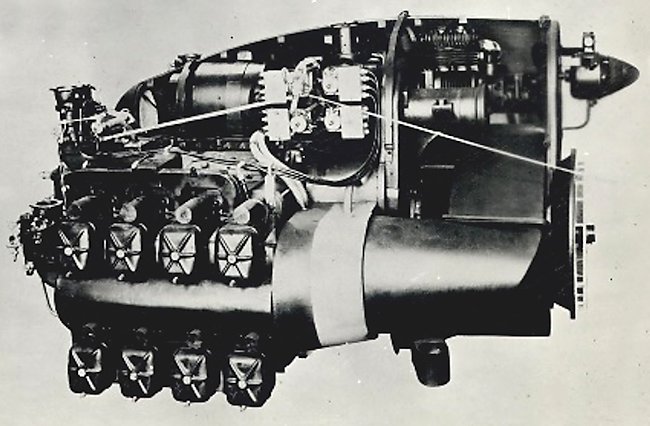
16 cylinder 510 horsepower Gipsy Major engine mock-up. Source: National Australian Archives MP730 10
To cope with the added weight, two new engine designs were proposed. The first consisted of four Holden Gipsy Major engines, providing an estimated 510 horsepower, to be mounted together in a two layer opposed piston setup and utilizing air cooling as opposed to the water cooled engines used previously.A non-functional mock-up of the engine, utilizing as many genuine parts as were available was produced. However, funding to continue development was denied due to termination of the tank project.
The second design was a 600 horsepower Michell type crankless engine, the design of which had been extensively developed by respected Australian Inventor A.G Michell in the 1920s. Director of Armoured Fighting Vehicle Production, Alfred Reginald Code, had been the chief draughtsman for Michell’s Crankless Engine Company from 1925 until the company’s closure in Australia in 1928. The crankless tank engine would have had several advantages, such as a smaller size to horsepower output ratio as well as a higher fuel efficiency. The design did not proceed beyond the drawing board.
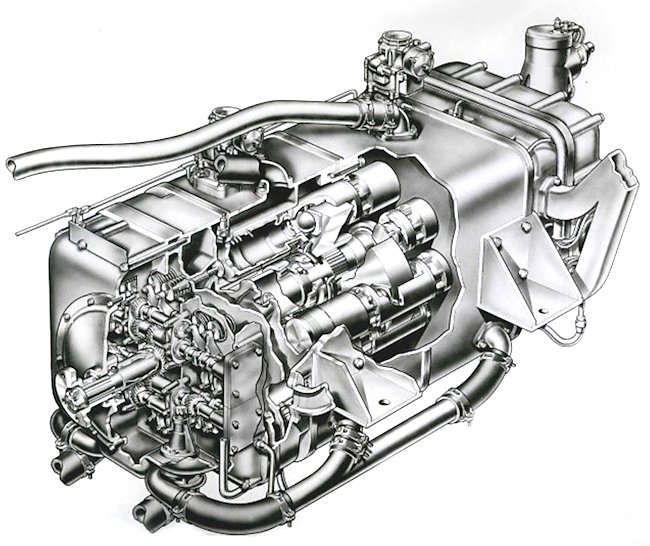
This cutaway drawing of the proposed 600 horsepower crankless tank engine. Source: National Australian Archives B6118 7
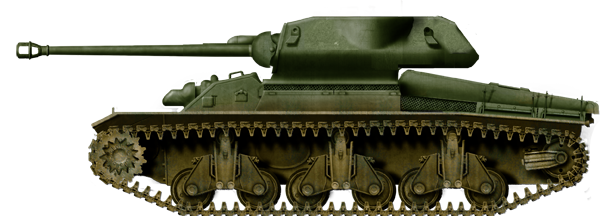
The AC IV prototype, based on the AC E1 – Illustrator: David Bocquelet

The AC E1 – Fitted with the new turret and 17 pdr gun, Fort Gellibrand Victoria, summer of 1943. Source:- Australian War Memorial PO3498.010
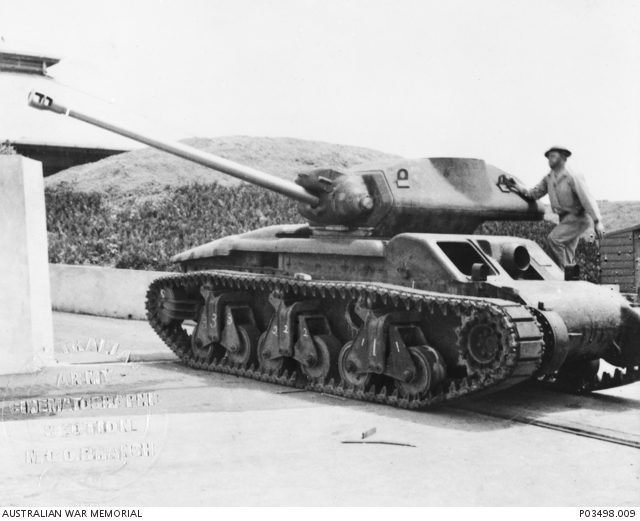
The AC E1 with the turret traversed to the right showing the elongated rear of the turret and higher turret roof, Fort Gellibrand Victoria, summer of 1943. Source:- Australian War Memorial PO3498.009
Always changing requests
In the quest for a modern tank design the army added a veritable laundry list of new requirements from late 1942 through to 1943, largely focused on standardising with the latest developments in US tank design. By early 1943, it was not clear to Australian authorities if the M4 Sherman would continue to be the standard tank of the US forces or be superseded by the T20 series of medium tanks.
Based on information received from US sources and the assessment of Col G.A Green on behalf of the US Army, desired upgrades included: US style all round vision cupola with additional crew vision blocs to be added around the turret. Ford GAA 525 horsepower tank engine to replace locally designed engines. Oilgear hydraulic turret traverse mechanism and Westinghouse 24 volt gyroscopic gun stabiliser. Removal of the turret basket in favor of crew seats suspended from the turret ring. Torsion bar suspension, or, if not possible, the implementation of US M4 type road wheels and revision to US rubber tracks. Replacement of the Methyl bromide fire suppression system with a Carbon Dioxide system. Arguably the most ambitious and outlandish proposal was the suggestion of a mechanical ammunition rack to better facilitate loading the 17 pounder gun.
‘Accordingly, a magazine containing 18 shells has been designed and this is located across the rear of the turret. The noses of the shells point towards the gun and the magazine has been equipped with gear to traverse each shell in turn to the centre for loading’ – tank production programme Report, on behalf of Director AFVP A.R Code to Mr Pryke, July 21st 1943
Not in vain
The termination of the entire Australian Cruiser program in mid-1943 was dictated by a mixture of practical and budgetary reasons as well as an ongoing political rivalry between the Ministry of Munitions and the Army.
Despite the Australian tanks never seeing combat use, one notable benefit to the development of Allied tanks did occur as a result. In 1943, Colonel Watson returned to the UK after his secondment to the Australian tank program ended. Watson brought with him documents related to the Australian tank program, including photographs and drawings of the 17 pounder mounting on the AC IV prototype.
The experimental 17 pounder mounting complete with mantlet dismounted from the E1 tank. The modified recuperator system can be seen extending out into the mantlet bulge above the gun barrel. Source: Ed Francis
Watson received a great amount of interest regarding the Australian work with the 17 pounder, notably from Sir Claude Gibb who was adamant that the 17 pounder could be mounted in an M4 Sherman turret, but faced severe opposition from the parties arguing otherwise. Subsequently, a series of meetings was convened where Watson was invited to provide detailed information about the Australian 17 pounder tank mounting, information which significantly expedited the decision to mount the 17 pounder gun on what would later become the Sherman Firefly.
Surviving vehicle
The Australian Armour and Artillery Museum displays a mock-up of the AC IV prototype, assembled from a 17 pounder gun barrel fitted to a fabricated replica of the AC IV mantlet and a salvaged AC III turret, mounted to a salvaged AC I hull. The remains of the AC I E1 prototype hull were held in the collection of the Melbourne tank museum until its closure in 2006. The E1 hull was not listed as an item in the auction of the Museum’s collection and its eventual fate is not known.
An article by Thomas Anderson
AC IV specifications |
|
| Dimensions | 6.32 x 2.77 x >2.56 m (20’9” x 9’7” x >8’4”) |
| Crew | 4 (commander, loader, gunner, driver) |
| Propulsion | 3 x V8 Cadillac ‘Cloverleaf’ 330 hp total, 12 hp/t 3 x V8 Cadillac ‘Perrier Cadillac’ 395 hp total Ford GAA, 525 hp 16 cylinder Gypsy Major, 510 hp Michell type crankless engine, 600 hp |
| Suspensions | Horizontal volute springs (HVSS) |
| Armament : | 17-Pounder (76.2 mm/3 in), 54 rounds Vickers .303, (7.9 mm) |
| Armor | From 45 to 65 mm (1.77-2.56 in) |
Links and Resources
Australian War Memorial Archives
The AC Sentinel on Wikipedia
Tank Hunter

Mock-up of the AC IV prototype on display at the Australian Armour and Artillery Museum

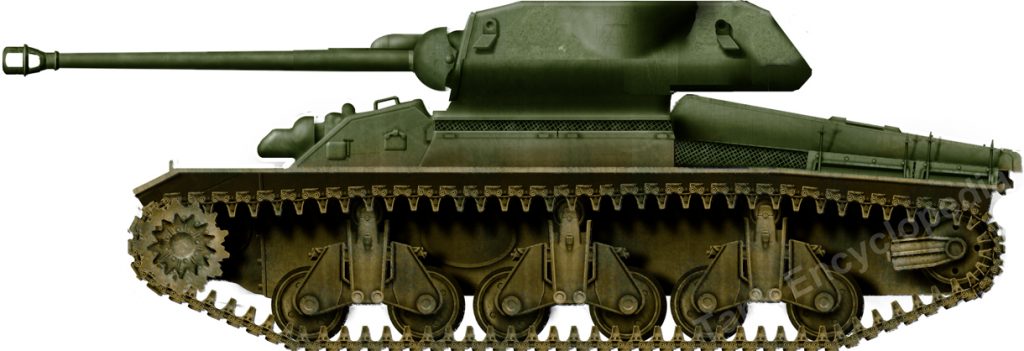

20 replies on “AC IV 17-pdr Armed Sentinel Cruiser Tank”
Basically Australia did not need a 17 pdr armed tank to deal with flimsy Japanese tanks. By 1942-43 the Grant/Lee and Matilda from North Africa were arriving in India in larger numbers than Australia could produce with the Sentinel. That Australia designed and was able to build any tanks at all was a wonder considering the nation had no tank producing experience prier to WWII.
You make some good points, and you’re about 95% correct. It does seem strange to build a 17 pounder armed tank to fight the lighter Japanese tanks, but the Australian Cruisers were always designed with the North African theatre and fighting German tanks in mind, the Japanese were considered in regards to potential invasion after late 1941 but their tanks didn’t set the benchmarks like the Germans did .
Based on my research I personally believe that Australia could have reached a suitable production rate of tanks by the end of 1943-early 1944, however by this point in time it was clear that Australia would only be fighting in the Pacific where a slow infantry tank like the Matilda was more use than a high speed cruiser tank. Additionally the early war enthusiasm for armour had dissipated and most of the Australian armour units were gradually disbanding now that the threat of Japanese invasion and the chance of combat in Africa/Europe was past.
Also like with everything there was politics, the politicians thought the project was too expensive, and there were factions in the Army that had bitter rivalries with the civilian AFV Directorate, and basically spent 1941 onward trying to discredit the AFV Directorate and regain control of tank design which they (wrongly considering the Army’s earlier poor efforts) thought was their rightful domain
One question though if the allies were to invade the Japanese homelands, whould the AC w/ 17 pounder be needed for the heavier vehicles like the type 3 Chi Nu and Type 5 Chi Ri?
The invasion of the Japanese islands would probably have been a US-only affair.
Operation Downfall, the plan to invade the Japanese mainland if the Manhatten project failed or an other number of things went different, and the Japanese didn’t surrender would have consisted of soldiers from: The US, The UK, Canada, and Australia
There’s no doubt after the Manchuria campaign with the Soviets taking the whole of Sakhalin & all the Kurils the Americans would not be able to stop the Soviets invading Japan’s main Northern Island, Hokkaido. As they were virtually within artillery range of it
That turret looks pretty crammed… How much room was in there, did they have a radio? Or did the 17pdr take up mostly all the space? Also why is the gun mantlet so flat and odd looking?
-Reply Please-
Oh, one last thing. Exactly how powerful was the 17pdr?
The tank was only ever built as a mock up, so basically they put a gun into a new turret and put it on the tank too see if it would work or not ie will the turret fall off if we fire this gun? There was no radio fitted, nor a lot of the other equipment that a production tank would have, because it was only really to prove that they gun mount worked, the actual production design would have been different. Archival sources say the turret ring diameter on the test tank was 64 inches but it was decided that production vehicles would have a turret ring of 70 inches minimum (final number was 72′), but serial production never happened
As for the mantlet looking flat, I’m not quite sure what you mean as the multiple angle B&W photos seem to show the various angles of it. If you’re talking about the mock up at the AAAM its not the original tank but an (approximate) representation made from salvaged AC I and AC III parts, the mantlet is just a non functional replica (made from fibreglass I think) with a 17 pounder barrel stuck in it, and the turret is not correct
oh lol posted a comment with out even reading the whole comment section my bad
i would imagine yes, that the 17pdr took up most of the space since the m4 Sherman ran into problems with space(having to add a extension to the turret for the radio) and the AC4 looks like it has a smaller turret. Also i would imagine they would have a radio for some kind of communication/coordination idk where they would put it though, maybe in the hull of the tank?
At 100 meters, about 171 mm of RHA penetration, given at 80-90 degrees angle. Correct me if I’m wrong.
Im missing the T28 Super Heavy Tank, T30, T29, T32, T34 mostly the ww2 T-series experimentals
The T-28 was a pre WWII medium ‘land battleship’ inspired by the British Vickers-Armstrong Ltd. 16 ton multi-turreted tank (Medium Tank MK III, A6). The T-28’s main turret was armed with the (L10) 76.2mmL26.5 and a co-axel 7.62mm DT MG plus 2 forward hull mounted DT MG turrets for a total of 3 turrets.
At the same time the Soviets designed and built the T-35 heavy ‘land battleship’. Both types were slow, mechanically unreliable (T-35 more so), thinly armored, large targets. The T-35’s main turret was the same as the T-28 but had 2 forward hull turrets one MG armed the other armed with a 45mm AT gun. Plus 2 hull mounted hull mounted turrets aft of the main turret these turrets were also armed with one MG and one 45 AT gun for a total of 5 turrets.
He means this T28
http://www.allthingslouisville.com/attractions/Patton%20Museum/Images/T28-4.jpg
OH! Not the T-28 I’m familiar with.
What was that big hole on the front of the hull? Some kind of cooling System..?
That’s where the distinctive bow machine gun would’ve gone.
– TE Moderator
Thank you Mark! 🙂
i kinder wish that thay went ahead and used it